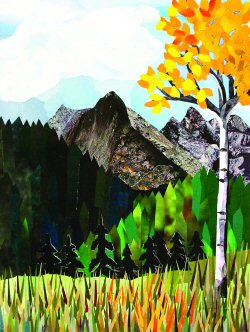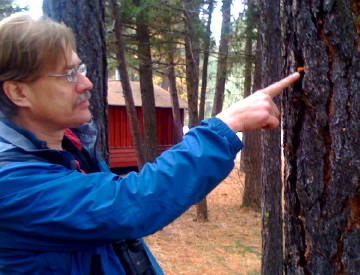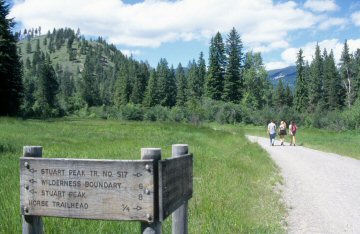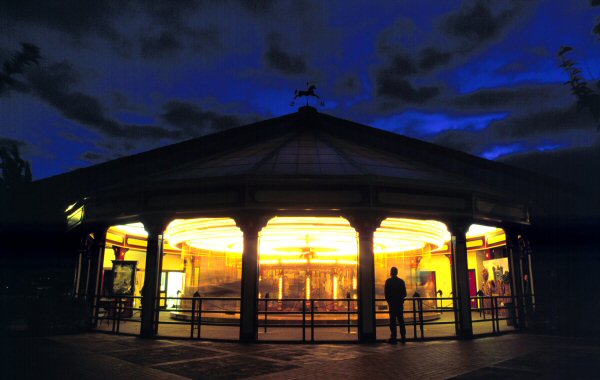Journalists are eligible for free email subscriptions to SEJournal, including TipSheet, WatchDog (on access issues) and more.
SEJ's 20th Annual Conference
Missoula, Montana
October 13-17, 2010
Hosted by The University of Montana
| Agenda | Coverage | Lodging/Transportation | Exhibits/Receptions | Missoula | Coverage |
Wild Rockies and the Changing West
 |
|
© Spanish Creek by Margaret Emerson. |
Even Congress praises Montana as The Last Best Place. A great deal is packed into the lyrical nickname. Start with a scenic landscape that features vast wilderness areas, iconic national parks and forests, free-flowing rivers and clear lakes. Grizzly bears, wolves, bison and native fish roam in relatively intact ecosystems. Native American tribes, ranchers, loggers and miners are in the mix, assertively managing natural resources.
But Montana's special qualities are threatened by increasing problems — a microcosm for how the North American West is the nation’s fastest-changing region. So here's an invitation: Come to Montana to explore the theme, Wild Rockies and the Changing West. See for yourself, for instance, how the region is arguably No. 1 for climate change impacts — by walking the ground in the aftermath of record-breaking wildfires, or through massive forest insect outbreaks, or by assessing other evidence of climate shifts that will soon require a renaming of Glacier National Park.
See how the region is also No. 1 for charismatic wildlife and wilderness under stress, rampant outdoor recreation and alternative energy projects, population growth and sprawl consuming open space, and private-land conservation deals on millions of acres. All that comes on top of historical problems such as wide-scale reckless mining and logging and campaigns to eradicate predators.
The University of Montana in Missoula — crowned by Rolling Stone magazine as the “most scenic campus in America” — will host the SEJ conference Oct. 13-17 (see below for more on the campus and Missoula, a happening town on the cusp of Old and New West).
Conference tours will include Glacier, a Superfund extravaganza, the research navy on the West’s largest freshwater lake, and the environmental programs of one of Montana’s seven Indian reservations (see the agenda for more on tours).
We’ll feature SEJ’s typical impressive array of speakers, panels and workshops. They’ll include Montana celebrities, Obama administration officials and experts filling you in on regional, national and international topics. Expect sessions on environmental law and politics (Montana likely has the highest ratio of professional environmentalists per capita), free-market environmentalism (Montana has the leading think tanks), environmental justice (focusing on Libby, a Montana mining town where asbestos has killed hundreds and EPA has declared a public health emergency), and the cutting-edge technologies and philosophical questions of modern wildlife biology. We’ll cap it off with famous Western authors who’ll explore our connections with the natural world.
We know Montana is a long haul for many. We’ll make it worth your investment. Lodging and other expenses will be affordable. Mark your calendar and consider an extended stay — we’ll guide you to interesting activities and scenery away from the conference. Bring your family, your fly rod, hunting gear, hiking shoes, and binoculars.
Finally, don’t forget… we’ll also be celebrating SEJ’s 20th anniversary with a big bash up in the mountains at the rustic-chic Montana Snowbowl lodge!
Conference co-chairs,
James Bruggers
Senior Reporter
The (Louisville) Courier-Journal
Ray Ring
Senior Editor
High Country News
“In the company of mountains, among the everlasting hills, we are supported and consoled by the thought of permanence, by our impermanent fellowship with permanence. There, here, within a hand’s grasp is immortality. The mountain is, and so am I, forever and forever.”
— A. B. Guthrie Jr., Big Sky, Fair Land
ABOUT SEJ
 |
|
SEJ Conference Director Jay Letto investigates Pine Bark Beetle damage. |
Founded in 1990, SEJ is the world’s oldest and largest membership association of professional journalists, educators and students dedicated to more and better coverage of environmental issues. SEJ’s mission is to strengthen the quality, reach and viability of journalism across all media to advance public understanding of environmental issues. As a grassroots educational group dedicated to the highest standards of public service journalism, SEJ is independent and nonpartisan. All SEJ programs, publications and services are designed and organized by journalists. The group has more than 1,500 members working in print, broadcast and online news media throughout the U.S., Canada, Mexico and 27 other countries. Their reporting reaches millions of readers, listeners and viewers worldwide, on a daily basis.
THE UNIVERSITY OF MONTANA
 The 156-acre campus in Missoula makes a beautiful spread near the confluence of three rivers. The university has renowned faculty such as Steve Running, a co-winner of the Nobel Peace Prize for his work on climate change; Chris Servheen, the top federal grizzly-bear biologist; and Jerry Bromenshenk, who uses honeybees to assess environmental hazards. Other faculty expertise ranges from geosciences and river restoration to environmental writing, forestry and environmental law. The university’s programs include the Flight Laboratory, where birds are studied in wind tunnels, particle image velocimetry, 3-D kinematics and slowmotion video. There are 129,000 plant specimens in the university herbarium, 24,000 animal specimens dating back to the 1800s in the zoological museum, a 28,000-acre experimental forest and a farm that grows food for the campus and low-income families. You can walk trails from campus along Missoula’s riverbanks or hike switchbacks up Mount Sentinel to an overlook of the urbanized valley. Campus map.
The 156-acre campus in Missoula makes a beautiful spread near the confluence of three rivers. The university has renowned faculty such as Steve Running, a co-winner of the Nobel Peace Prize for his work on climate change; Chris Servheen, the top federal grizzly-bear biologist; and Jerry Bromenshenk, who uses honeybees to assess environmental hazards. Other faculty expertise ranges from geosciences and river restoration to environmental writing, forestry and environmental law. The university’s programs include the Flight Laboratory, where birds are studied in wind tunnels, particle image velocimetry, 3-D kinematics and slowmotion video. There are 129,000 plant specimens in the university herbarium, 24,000 animal specimens dating back to the 1800s in the zoological museum, a 28,000-acre experimental forest and a farm that grows food for the campus and low-income families. You can walk trails from campus along Missoula’s riverbanks or hike switchbacks up Mount Sentinel to an overlook of the urbanized valley. Campus map.
- All photos by Todd Goodrich, UM Photographer, The University of Montana unless noted otherwise.
MISSOULA
 |
|
Rattlesnake trailhead. |
Between conference events, stroll on riverside trails out the back of your hotel and walk around downtown or through campus. Downtown is the vital core of a metro area of 65,000 residents, with colorful brewpubs and old timber-industry saloons, trendy shops and coffee joints, creative urban infill and green buildings, and an airport served by three major airlines. Missoula is headquarters for major conservation groups and institutes such as the Rocky Mountain Elk Foundation, the 123-year-old Boone and Crockett Club, Institutes for Journalism & Natural Resources, the Adventure Cycling Association and Outdoor Writers of America, as well as regional offices for groups such as the National Wildlife Federation and Trout Unlimited. A five-minute drive from downtown takes you to the trailhead for a national wilderness area, the Rattlesnake. Roughly an hour’s drive takes you to several national wildlife refuges featuring bison and waterfowl; it’s two-and-a half hours to Glacier National Park and five hours to Yellowstone National Park.
-
Missoula-based author and environmental writer Richard Manning welcomes you to his town with suggestions of what you can do on foot while you are attending SEJ's 20th Annual Conference. It's a college town nestled in a Rocky Mountain valley that you won't want to miss.
-
Journalist Scott McMillion ponders Montana as the Last Best Place in a video essay on the PBS Newshour.
 |













 Advertisement
Advertisement 



